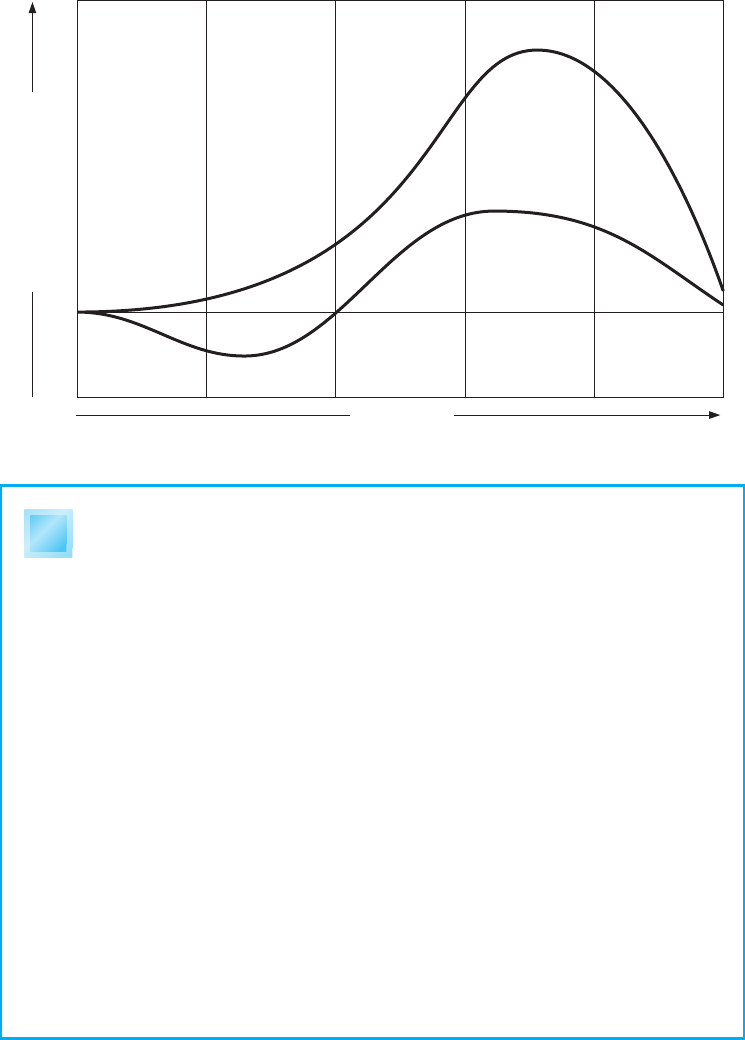
170 CHAPTER 8 GETTING TO GROSS PROFIT
If you have found intimate relationships between your sales and indicators that are not
included in the forecasts, you need to take one more step. You have to identify a relation-
ship between your leading indicator and an appropriate series that is forecast (such as
gross national product (GNP) or gross domestic product (GDP), measures of total eco-
nomic activity – consumer spending, investment, etc.). Sen s ible judgement is required.
Up close and personal – industry and product
demand
As useful as they are, leading indicators have one shortfall. They predict the future using
past relationships – and, as Henry VIII with his six wives taught us, relationships can
change. As indicated earlier, trends in culture and fashion, fads, advertising, product pro-
motions and so on can cause changes at three levels, in demand for:
a product class (for example, travel);
a product category (air travel);
your product (your specific air travel services).
If you want to read more about these subjects, you might like to read two of my
other books – The Economist Guide to Economic Indicators and The Definitive Guide to
Business Finance. The title of the first is self-explanatory. The second one considers
time series analysis, forecasting and a whole range of interesting analytical methods
to assist management decision-making and financial management.
Estimates, projections and forecasts
In the context of this chapter:
an estimate, as already discussed, happens when you fill in missing
knowledge about the present;
a projection or extrapolation is the future predicted using a ruler;
a forecast is a logical view of the future developed using knowledge of
relationships between various indicators;
an assumption is a cross between a projection and a forecast. It is a best
guess which you use for the sake of the forecast. For example, you might
make a series of assumptions about exchange rates that are the basis for
various forecasts.
t

UP CLOSE AND PERSONAL – INDUSTRY AND PRODUCT DEMAND 171
What do you do? You add a couple of lines to your forecast making additional provision
for these changes. You have already examined the external environment (Chapter 5) and
developed a marketing strategy (Chapter 6). Now you have to assess how the pattern of
product demand might change during the months and years ahead.
Some of this will be judgemental. You might estimate that your competitors’ strategies
will add 2% to overall demand for the product class, or increase their market share by 5%.
However, you may also be able to make some more rigorous forecast based on your anal-
ysis. For example, you might know that a given amount of spending on advertising or an
additional telemarketing person will boost your sales by a certain amount.
One technique that might help is to examine the life cycle for your product class and
category as well as for the product itself.
Test marketing
When starting a new business, planning a new product or entering a new market
segment, you should really conduct some test sales. These will help you plan future
sales. You might also find it impossible to raise finance without such proof of demand.
An illuminating story comes to mind. The inventor of a well-known household
workbench offered it to two major do-it-yourself companies.
The first company reviewed the product and conducted some market
research. The company subsequently wrote to the inventor declining
the product on the basis that there was a market for only a few dozen
workbenches in the whole of Europe.
The second company told the inventor to speak to them again when he had
proved that there was a market.
The enterprising entrepreneur manufactured the workbenches in his spare
bedroom, placed an advertisement in a small newspaper – and immediately sold
thousands by mail order. One company lost out, the other could well have done.
This is typical of big corporations – including many venture capital providers.
Managers are trained to follow rules and avoid risks. They sometimes appear to
lose their feeling for the markets and become a touch myopic. If you are writing
a business plan for a new product, you will frequently think that you are the only
person who sees the potential. Frankly, this will probably be the case. If you can
prove that you are right by making test sales, your plan will almost certainly be
approved much more readily.
t
172 CHAPTER 8 GETTING TO GROSS PROFIT
PRODUCT LIFE CYCLES
In varying degrees, all products, categories and classes go through the following stages of
being (illustrated in Figure 8.3). Where does your product fit in?
Development
R&D and marketing people are busy being creative behind the scenes. They are having
a good time without having to account for sales – which have not yet begun. Revenue is
zero, but cash is being poured eagerly into product development and pre-launch market-
ing activities.
Introduction
The product is launched, probably with lots of publicity. The marketing people are in
their element. R&D is starting a witch-hunt about missed deadlines and overshot budgets
and production is scratching its collective head over glitches in output. Sales generally
increase slowly at first while buyers are learning about the existence of the amazing prod-
uct. The company starts to recover some of the initial investment.
Growth
Market awareness and acceptance are growing. The production machinery is humming.
Sales are expanding strongly and profits are booming – funding R&D’s next journey into
the unknown. Everyone is having fun.
Maturity
The market is becoming saturated. Laggards are still buying, but the herd is stampeding
after new products. Outlays rise as the marketing department struggles to maintain sales.
Profits have passed their peak and are beginning to fall off.
Decline
The product has had its day. Ex-prisoners and former commune-dwellers coming back
into circulation might buy a few, but sales are dwindling. Profits slump. Production
capacity is underused. R&D and marketing people are seen hunched over blueprints for
different products. Tempers are frayed.
Of course, not all products make it out of R&D or through the introductory stage. Many
fall by the wayside. You want to get through these first two stages (development and
introduction) as rapidly as possible, and extend the growth stage for as long as you can.
This is where product and market modifications help – where you can extend the profit-
able growth period by breathing new life into limp products. Knowing where you are in
the product life cycle, and where you are likely to be heading, is a useful aid to planning
and forecasting.

UP CLOSE AND PERSONAL – INDUSTRY AND PRODUCT DEMAND 173
Sales and profits (dollars)
Development Introduction Growth Maturity Decline
Zero
Time (years)
Sales
Profits
Figure 8.3 The five ages of product
Ask an expert
There are three groups of people that you can turn to for expert opinions:
Your customers. Surveys of buying intentions can reveal quite succinctly the
potential of your market.
Your sales force. Sales professionals often have a very close handle on their
market. Order books might give a very clear indication of projected sales for
many months ahead if you are building oil-rigs or aircraft with long order
times. Alternatively, your sales people may know about their customers’
buying intentions. Otherwise, you might be able to play the numbers game.
So-many cold calls will generate so-many leads that will result in so-many
sales. You already know your plans, the number of sales staff, the number of
calls that they can make – the rest is down to simple arithmetic.
Other experts. You might want to have a word with trade associations,
marketing consultants, distributors, re-sellers, suppliers, other business
partners. Nothing is lost by listening and you could gain valuable insight or
ideas. You might even find an opportunity for a co-operative venture.
t
..................Content has been hidden....................
You can't read the all page of ebook, please click here login for view all page.
